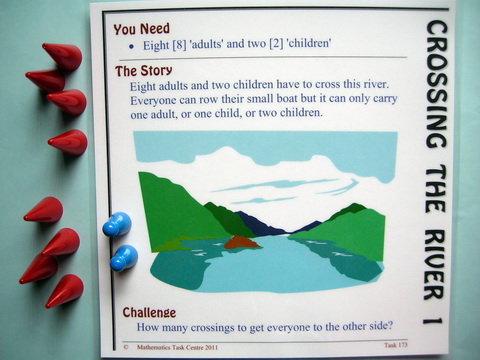
Crossing The River 1Task 173 ... Years 4 - 8SummaryThe story shell sets up a problem that can be solved using content free logic, so the investigation is easy to state and easy to start. But, having solved it, how many crossings did it take? That question begins to introduce mathematical content and following with the mathematician's question What happens if ... we change the number of adults? leads into extensive pattern and algebra work.This cameo includes an Investigation Guide. |
Materials
Content
|

IcebergA task is the tip of a learning iceberg. There is always more to a task than is recorded on the card. |
No mathematics as such is required to work out this task. It can be thought through by asking what the choices are for the first move and exploring the steps that follow until a successful sequence is discovered. A visual/kinaesthetic pattern develops when the successful path is chosen. It will help to consolidate that pattern if the students are asked to record their solution...

...and in the process they are likely to realise, or confirm, that it takes 4 trips to shift each adult across the river and one extra trip to bring a child over for the last time. Symbolically, this can be written as T = 4 x A +1 ...and every symbol makes sense in the context of the problem.
Special Note A Every adult must make one trip on their own. So, if there are 8 adults, there has to be 8 crossings and for this to happen, for each adult, the children must make 3 trips.For this reasoning, the appropriate symbolic representation is
The number of trips for 8 adults and 2 children is 33, but having solved a problem, a mathematician asks what else can be learned from it. Crossing The River 1 begs questions such as:
An Investigation Guide addressing the questions above, and more, has been extracted from Maths With Attitude Pattern & Algebra Years 7/8. This kit includes Investigation Guides for the 19 other tasks in the kit. If this guide doesn't suit the year level you are working with, then consider using it as a model for creating your own guide and submitting it to share with colleagues. ExtensionBy changing the structure of the problem slightly Crossing The River 1 can be used with young children. For example, in the Working Mathematically with Infants kit, the problem is presented in the Year 1 Planner as a whole class investigation requiring 2 adults and 4 children to cross the river. The rowing rules remain the same. The kit includes many other investigations based on tasks which have been adapted for use with younger children, and extensive use of Threaded Activities developed in the Calculating Changes network.
Special Note B A couple, who are of equal weight, have two children, each of whom weighs half the weight of one of the adults. All four people need to cross a river, but their boat will only hold the weight of one adult. How can they cross in safety?
Source: From 0 to Infinity in 26 Centuries
|
Whole Class InvestigationTasks are an invitation for two students to work like a mathematician. Tasks can also be modified to become whole class investigations which model how a mathematician works. |
Crossing The River 1 cries out to be converted to a whole class lesson by acting out the story. The rhythm in the solution becomes apparent to all and it confirms that the problem can be solved. However, seeing it done by others and doing it yourself are not the same thing, so: Great work. Our actors have shown us that it can be done, but can you do it? With a partner, use your Poly Plug to set up the story and follow the problem through. But this time I want you to count the number of trips as well.Invite teams to write their answer for the number of trips on the board and, if necessary, discuss any differences between the answers. Then ask students to record the solution process in their journal ...because that's what mathematicians would have to do. A diagram like the one above is common, but it is not the only way. The lesson continues with the question What happens if we change the number of adults? and making a table of results. Organising the table will lead to a pattern which is consistent with the rhythm perceived in the acting out. This whole class process can be supplemented with the Investigation Guide which can also be used as an assessment tool. For more ideas and discussion about this investigation, open a new browser tab (or page) and visit Maths300 Lesson 23, Crossing The River, which includes a different Investigation Guide with answers and discussion. Visit Crossing The River 1 in Menu Maths Pack A.
Special Note C The book contains 49 tutorials organised by title, year level and content. That's enough for several years of staff meetings. Each tutorial may be copied and used as a discussion starter in staff meetings. Read more about ordering Maths300 ETuTE.
|
Is it in Maths With Attitude?Maths With Attitude is a set of hands-on learning kits available from Years 3-10 which structure the use of tasks and whole class investigations into a week by week planner. |
The Crossing The River 1 task is an integral part of:
The Crossing The River 1 lesson is an integral part of:
|